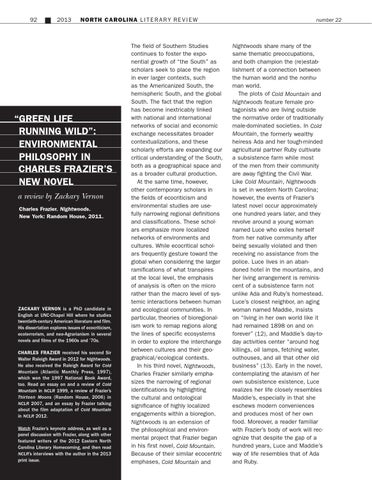92
2013
NORTH CAROLINA L I T E R A R Y RE V I E W
“green life running wild”: Environmental Philosophy in Charles Frazier’s New novel a review by Zackary Vernon Charles Frazier. Nightwoods. New York: Random House, 2011.
Zackary Vernon is a PhD candidate in English at UNC-Chapel Hill where he studies twentieth-century American literature and film. His dissertation explores issues of ecocriticism, ecoterrorism, and neo-Agrarianism in several novels and films of the 1960s and ’70s. Charles Frazier received his second Sir Walter Raleigh Award in 2012 for Nightwoods. He also received the Raleigh Award for Cold Mountain (Atlantic Monthly Press, 1997), which won the 1997 National Book Award, too. Read an essay on and a review of Cold Mountain in NCLR 1999, a review of Frazier’s Thirteen Moons (Random House, 2006) in NCLR 2007, and an essay by Frazier talking about the film adaptation of Cold Mountain in NCLR 2012. Watch Frazier’s keynote address, as well as a panel discussion with Frazier, along with other featured writers of the 2012 Eastern North Carolina Literary Homecoming, and then read NCLR’s interviews with the author in the 2013 print issue.
The field of Southern Studies continues to foster the exponential growth of “the South” as scholars seek to place the region in ever larger contexts, such as the Americanized South, the hemispheric South, and the global South. The fact that the region has become inextricably linked with national and international networks of social and economic exchange necessitates broader contextualizations, and these scholarly efforts are expanding our critical understanding of the South, both as a geographical space and as a broader cultural production. At the same time, however, other contemporary scholars in the fields of ecocriticism and environmental studies are usefully narrowing regional definitions and classifications. These scholars emphasize more localized networks of environments and cultures. While ecocritical scholars frequently gesture toward the global when considering the larger ramifications of what transpires at the local level, the emphasis of analysis is often on the micro rather than the macro level of systemic interactions between human and ecological communities. In particular, theories of bioregionalism work to remap regions along the lines of specific ecosystems in order to explore the interchange between cultures and their geographical/ecological contexts. In his third novel, Nightwoods, Charles Frazier similarly emphasizes the narrowing of regional identifications by highlighting the cultural and ontological significance of highly localized engagements within a bioregion. Nightwoods is an extension of the philosophical and environmental project that Frazier began in his first novel, Cold Mountain. Because of their similar ecocentric emphases, Cold Mountain and
number 22
Nightwoods share many of the same thematic preoccupations, and both champion the (re)establishment of a connection between the human world and the nonhuman world. The plots of Cold Mountain and Nightwoods feature female protagonists who are living outside the normative order of traditionally male-dominated societies. In Cold Mountain, the formerly wealthy heiress Ada and her tough-minded agricultural partner Ruby cultivate a subsistence farm while most of the men from their community are away fighting the Civil War. Like Cold Mountain, Nightwoods is set in western North Carolina; however, the events of Frazier’s latest novel occur approximately one hundred years later, and they revolve around a young woman named Luce who exiles herself from her native community after being sexually violated and then receiving no assistance from the police. Luce lives in an abandoned hotel in the mountains, and her living arrangement is reminiscent of a subsistence farm not unlike Ada and Ruby’s homestead. Luce’s closest neighbor, an aging woman named Maddie, insists on “living in her own world like it had remained 1898 on and on forever” (12), and Maddie’s day-today activities center “around hog killings, oil lamps, fetching water, outhouses, and all that other old business” (13). Early in the novel, contemplating the atavism of her own subsistence existence, Luce realizes her life closely resembles Maddie’s, especially in that she eschews modern conveniences and produces most of her own food. Moreover, a reader familiar with Frazier’s body of work will recognize that despite the gap of a hundred years, Luce and Maddie’s way of life resembles that of Ada and Ruby.
